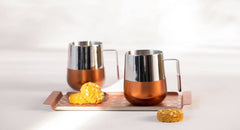Maintaining the Shine - Care and Cleaning Tips for Stainless Steel Kitchens
Stainless steel kitchens, which offer a clean and elegant look coupled with durability and corrosion resistance, are increasingly found in modern homes. Still, regular cleaning and care are essential if you want them to stay sparkling and lustrous. This guide will discuss some ideas and methods for keeping your stainless steel kitchen looking fantastic for many years to come, including how to remove rust from stainless steel effectively.
Essential Tips on How to Remove Rust from Stainless Steel:
1. Choose the Right Cleaning Agents:
Maintaining stainless steel surfaces depends heavily on using the correct cleaning agents. Strong abrasives or cleansers, such as ammonia, bleach, or chlorine, should be avoided since they will compromise the stainless steel finish. Select either very mild dish soap, baking soda, or particular stainless steel cleansers. These are crucial in how to remove rust from stainless steel.
2. Use Soft, Non-Abrasive Cloths:
Soft, non-abrasive cloths or sponges will help you clean your stainless steel appliances or counters without damaging their surface. Microfiber towels are very effective at removing smudges and fingerprints without leaving any streaks behind. This method also applies when learning how to clean burners on gas stove.
3. Follow the Grain:
Generally speaking, the grain pattern of stainless steel surfaces resembles that of wood. Wiping with the grain helps to more effectively remove dirt and grime while lowering the danger of scratching. Always follow the grain when you are cleaning your stainless steel kitchen. This is a fundamental technique in how to remove rust from stainless steel.
4. Baking Soda and Water Paste:
A mixture of baking soda and water can effectively eliminate persistent stains and grease buildup. After the paste is applied to the afflicted area, gently wipe with a sponge or soft cloth. Baking soda's mild abrasive qualities aid in eliminating stains without compromising the stainless steel surface. This method is also an excellent oil stain remover in kitchen scenarios.
5. Vinegar Solution for Shine:
Vinegar can bring back the gloss to dull stainless steel appliances. Fill a spray container with an equal mixture of water and vinegar and spritz the surface. Following the grain, wipe spots and give the stainless steel sheen using a microfiber cloth. This solution also helps in how to clean stainless sink effectively.
6. Dry Completely After Washing:
Always completely dry your stainless steel kitchen surfaces with a fresh towel following washing to prevent water streaks and mineral deposits. Water left to air dry can leave ugly scars that compromise the general look of your kitchen. Drying is a crucial step in how to remove rust from stainless steel and maintaining the overall appearance.
7. Use Stainless Steel Cleaner & Polish:
Use a specialist steel stain cleaner or protective finish to further preserve your stainless steel appliances and counters from fingerprints and smudges. These products provide a barrier that blocks dirt and streamlines cleaning, increasing the lifespan of the shine in your kitchen.
Conclusion:
Following these easy guidelines and including them in your normal cleaning schedule will help maintain the quality of your stainless steel appliances and counters, enhancing the appeal and utility of your house. Whether you're figuring out how to remove rust from stainless steel, how to clean burners on gas stove, or looking for the best oil stain remover in kitchen, these tips will ensure your kitchen remains pristine and functional.







Leave a comment
Note: Comments are published after moderation.